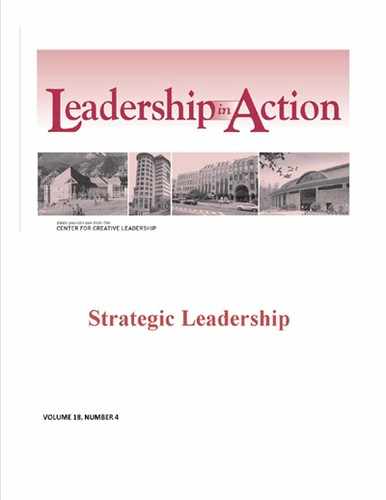Keys to Effectiveness
This framework provides a conceptual map of the territory of strategic leadership. Anyone in a strategic leadership role can use it to conduct an analysis of his or her own strengths, weaknesses, opportunities, and threats. A leader, for example, might discern that a key factor in his or her organization's becoming more responsive to the external environment is for the leader to work differently with the whole senior team. The framework itself does not say much about specific behaviors incumbent on strategic leaders. However, although we resist any simplistic set of rules for effective strategic leadership, we do believe several maxims should be considered.
Do More Than Conceive and Then Carry Out a Plan
Leaders must do more than merely develop and implement a strategic plan. I doubt that planning and implementation typically occur in a discrete linear sequence like this: the complete plan is developed, and then it is implemented and implemented just as written. In a seminal article, Henry Mintzberg likened strategy making to craftsmanship—more specifically, to the endeavors of the potter at the wheel. Mintzberg's metaphor is richer than I can do justice to here, but one aspect of it seems particularly appropriate. In likening strategy making to craftsmanship, Mintzberg notes the dynamic interaction between the potter's intentions and the work of the potter's hands with the clay. As the wheel turns and the clay changes shape, the potter's initial intentions may be displaced by new possibilities that take shape on their own as the mind, hands, and clay interact.
Planning and implementation seldom occur in a discrete linear sequence.
So it is with strategy making and strategic leadership. It may be most accurate and helpful to think of strategy as continually evolving as it is continually implemented. It reflects the joint work of head and hands, not just of the head. For too long we have viewed strategy making (and thus strategic leadership) as a purely rational, top-down, formal process.
Understand That Strategic Leadership Is an Interpersonal Process, Not an Administrative Procedure
To some extent, understanding leadership as an interpersonal process is a corollary of the first point. Strategic leadership is not an administrative procedure designed to produce, and then ensure everyone in the organization religiously follows, prescribed parts of a formal plan. Leaders need to attend to people's hearts as well as their heads; and when leadership attends to their heads, it should call forth a creative intelligence, not just a rule-following mentality. Leaders need to build commitment rather than merely ensure compliance. Furthermore, to say strategic leadership is an interpersonal process is to emphasize that leaders need to be influenceable as well as influential. Strategic leaders need to be open to ideas and opinions from others around them, not just conceivers and disseminators—even inspiring ones—of their own strategic ideas.
Ensure That Strategic Leadership Is Everyone's Responsibility
Strategic leaders are not just CEOs and top managers, and strategic leadership does not reside only in a particular department or even in the whole headquarters. Strategically significant ideas—those about a new product, a new process, a new market, for instance—may emerge from anywhere in an organization. Although not everyone shares equally in shaping or executing strategy, there is no telling where an idea of strategic significance will come from, and perhaps the most vital organizations will be those that have leaders who develop the best ways of stimulating, valuing, and disseminating new ideas. As Gary Hamel points out, there is no telling where the next revolutionary idea will come from; certainly no one should assume it can emerge only from the boardroom.
Orchestrate the Commitment of Diverse Resources for Sustained Competitive Advantage
In our discussions with DSL participants about what the word strategy means to them, several themes consistently emerged. Two of the most common associations with the word strategy were (1) maintaining a long-term focus, preferably including a vision of a desired future, and (2) coordinating the interplay of the diverse functions and actions of a complex organization. Leaders should look beyond immediate tasks and realities to a future that organizational members feel compelled to create. And leaders need to coherently allocate scarce and diverse resources in order to achieve an overall distinctive and competitive or advantageous position, all within a framework of rapid change and environmental uncertainty.
Leaders should look beyond immediate realities to a future that organizational members feel compelled to create.
Move People Toward Valued Ends, Not Just Numbers
As a final point, let me suggest that leaders do more than just guide an organization to make bottom-line numbers, especially short-term financial results. (I add this point fully aware that this is precisely the focus in many organizations.) I believe that leaders must have a longer-term focus than the next quarter, and that they must give their attention to broader objectives than financial ones. Perspectives on stakeholders or customers, internal business processes, organizational learning, and sustainability must also be considered. In other words, leaders need some type of balanced scorecard. As Robert Kaplan and David Norton point out, just as you probably wouldn't want to fly in a plane where the pilot was operating on a single instrument, you wouldn't want to work in an organization where the leaders were operating on just one measure.
You probably wouldn't want to fly in a plane where the pilot was operating on a single instrument.
